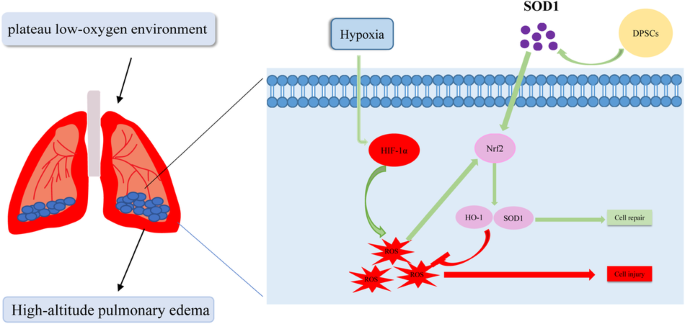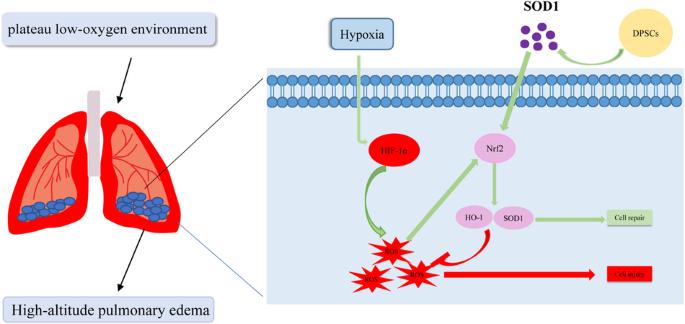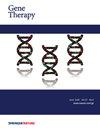超氧化物歧化酶1修饰的牙髓干细胞通过Nrf2/HO-1途径抑制氧化应激,缓解高海拔肺水肿
IF 4.6
3区 医学
Q1 BIOCHEMISTRY & MOLECULAR BIOLOGY
引用次数: 0
摘要
高原肺水肿(HAPE)是一种致命的高原病,目前尚无有效的治疗方法。牙髓干细胞(DPSCs)是从牙髓组织中分离出来的一种间充质干细胞,具有抗炎和抗氧化应激等多种功能。DPSC已被用于治疗多种疾病,但目前还没有治疗HAPE的研究。在这项研究中,Sprague-Dawley大鼠暴露于急性低压缺氧以建立HAPE模型,并通过尾静脉注射SOD1修饰的DPSCs(DPSCsHiSOD1)。检测肺动脉压、肺含水量(LWC)、支气管肺泡灌洗液(BALF)和肺匀浆的肺总蛋白含量、氧化应激和炎症指标,以评估DPSCsHiSOD1对HAPE的影响。用大鼠II型肺泡上皮细胞(RLE-6TN)研究DPSCsHiSOD1对缺氧损伤的影响和机制。我们发现,DPSCs能治疗HAPE,且效果优于地塞米松治疗。通过抗氧化应激和抗炎作用,SOD1修饰可增强DPSCs在改善肺组织结构、降低肺动脉压和LWC、减少BALF和肺匀浆中肺总蛋白含量方面的功能。此外,我们还发现 DPSCsHiSOD1 可通过减少活性氧(ROS)的积累和激活 Nrf2/HO-1 通路来保护 RLE-6TN 免受缺氧损伤。我们的研究结果证实,SOD1修饰可通过Nrf2/HO-1信号通路增强DPSCs的抗氧化应激能力。DPSCs,尤其是DPSCsHiSOD1,可能是治疗HAPE的一种潜在方法。DPSCs 治疗高海拔肺水肿的抗氧化应激机制示意图。DPSCs可通过释放超氧化物歧化酶1缓解氧化应激,从而减少ROS的产生并激活Nrf2/HO-1信号通路,以改善HAPE中的肺细胞损伤。本文章由计算机程序翻译,如有差异,请以英文原文为准。


Superoxide dismutase 1-modified dental pulp stem cells alleviate high-altitude pulmonary edema by inhibiting oxidative stress through the Nrf2/HO-1 pathway
High-altitude pulmonary edema (HAPE) is a deadly form of altitude sickness, and there is no effective treatment for HAPE. Dental pulp stem cells (DPSCs) are a type of mesenchymal stem cell isolated from dental pulp tissues and possess various functions, such as anti-inflammatory and anti-oxidative stress. DPSCs have been used to treat a variety of diseases, but there are no studies on treating HAPE. In this study, Sprague-Dawley rats were exposed to acute low-pressure hypoxia to establish the HAPE model, and SOD1-modified DPSCs (DPSCsHiSOD1) were administered through the tail vein. Pulmonary arterial pressure, lung water content (LWC), total lung protein content of bronchoalveolar lavage fluid (BALF) and lung homogenates, oxidative stress, and inflammatory indicators were detected to evaluate the effects of DPSCsHiSOD1 on HAPE. Rat type II alveolar epithelial cells (RLE-6TN) were used to investigate the effects and mechanism of DPSCsHiSOD1 on hypoxia injury. We found that DPSCs could treat HAPE, and the effect was better than that of dexamethasone treatment. SOD1 modification could enhance the function of DPSCs in improving the structure of lung tissue, decreasing pulmonary arterial pressure and LWC, and reducing the total lung protein content of BALF and lung homogenates, through anti-oxidative stress and anti-inflammatory effects. Furthermore, we found that DPSCsHiSOD1 could protect RLE-6TN from hypoxic injury by reducing the accumulation of reactive oxygen species (ROS) and activating the Nrf2/HO-1 pathway. Our findings confirm that SOD1 modification could enhance the anti-oxidative stress ability of DPSCs through the Nrf2/HO-1 signalling pathway. DPSCs, especially DPSCsHiSOD1, could be a potential treatment for HAPE.
求助全文
通过发布文献求助,成功后即可免费获取论文全文。
去求助
来源期刊

Gene Therapy
医学-生化与分子生物学
CiteScore
9.70
自引率
2.00%
发文量
67
审稿时长
4-8 weeks
期刊介绍:
Gene Therapy covers both the research and clinical applications of novel therapeutic techniques based on a genetic component. Over the last few decades, significant advances in technologies ranging from identifying novel genetic targets that cause disease through to clinical studies, which show therapeutic benefit, have elevated this multidisciplinary field to the forefront of modern medicine.
 求助内容:
求助内容: 应助结果提醒方式:
应助结果提醒方式:


